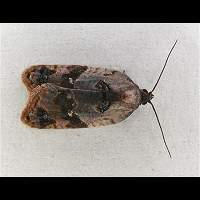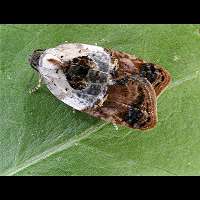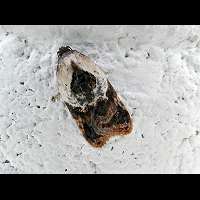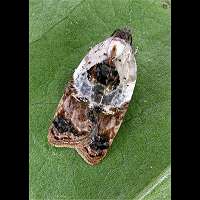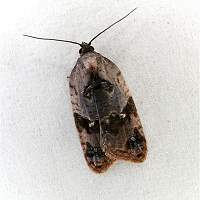Rose Garden Tortrix (Acleris variegana)
The Rose Garden Tortrix is a variable species, like most other Acleris species. Still this is one of the more easily identifiable of the Acleris genus, for the contrast between the first part of the wings and the latter part is always there. The first one third of the front wings is whitish, showing a big brownish black blob in the center, the remainder of the wings is brownish with a patch of variable size. This patch may be dark, like in the specimen in the pictures, but might also be as white as the first part of the wings is. The hind wings are grey. The legs are always ringed. Reaching a wingspan of some 16 to 19 mm it is a small species.
The eggs are yellowish or pale reddish and deposited one by one or in small groups on either side of the leaf of the foodplant, usually near the mid rib. The eggs hatch in spring. The larvae are pale green with a brownish head and pale brown real legs. Full grown larvae are some 12 to 14 mm. They feed in May and the beginning of June mainly, but are sometimes seen well into the first half of July. The pupa is only some 9 mm long and brownish. The pupal stage takes only some 2 to 4 weeks. In most of Britain adults appear from July to September, but a little later in cooler areas, where the period they are seen is also shorter. The larvae live on a great variety of plants, including apple, pear, raspberry, roses (including garden varieties), Berberis, apricot, cherry. The species does however not appear in huge numbers on one plant and usually there is not much damage done to the host plants.
The pheromone of this species is well known and sometimes used to attract the moths. It is a species that exclusively flies by night. It is attracted to bright lights occasionally, but in very small numbers only. In most parts of the world little is known about parasitic wasps or flies attacking larva or pupa. This is a very common species all over Europe, including much of Britain. It can also be found in Northern and Central Asia, China, Japan and Northern America.
This species is also known as the Variegated Button and the Fruit Tortricid.
The Rose Garden Tortrix is a variable species, like most other Acleris species. Still this is one of the more easily identifiable of the Acleris genus, for the contrast between the first part of the wings and the latter part is always there. The first one third of the front wings is whitish, showing a big brownish black blob in the center, the remainder of the wings is brownish with a patch of variable size. This patch may be dark, like in the specimen in the pictures, but might also be as white as the first part of the wings is. The hind wings are grey. The legs are always ringed. Reaching a wingspan of some 16 to 19 mm it is a small species.
The eggs are yellowish or pale reddish and deposited one by one or in small groups on either side of the leaf of the foodplant, usually near the mid rib. The eggs hatch in spring. The larvae are pale green with a brownish head and pale brown real legs. Full grown larvae are some 12 to 14 mm. They feed in May and the beginning of June mainly, but are sometimes seen well into the first half of July. The pupa is only some 9 mm long and brownish. The pupal stage takes only some 2 to 4 weeks. In most of Britain adults appear from July to September, but a little later in cooler areas, where the period they are seen is also shorter. The larvae live on a great variety of plants, including apple, pear, raspberry, roses (including garden varieties), Berberis, apricot, cherry. The species does however not appear in huge numbers on one plant and usually there is not much damage done to the host plants.
The pheromone of this species is well known and sometimes used to attract the moths. It is a species that exclusively flies by night. It is attracted to bright lights occasionally, but in very small numbers only. In most parts of the world little is known about parasitic wasps or flies attacking larva or pupa. This is a very common species all over Europe, including much of Britain. It can also be found in Northern and Central Asia, China, Japan and Northern America.
This species is also known as the Variegated Button and the Fruit Tortricid.


